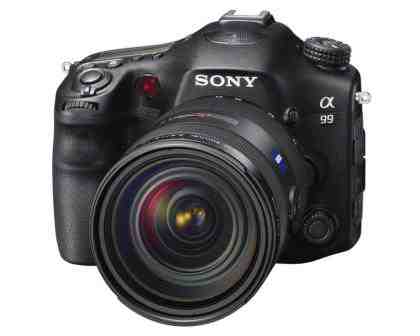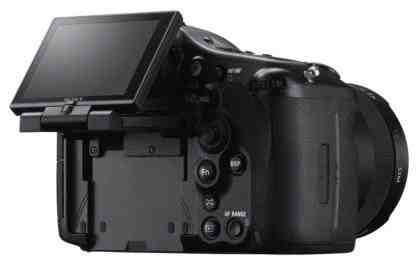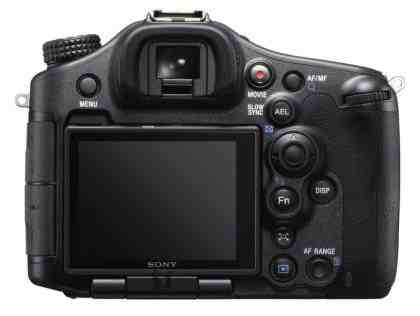Price above is for the A99 body only, no kits available at present, we tested with a 24-70mm f/2.8 Carl Zeiss Vario-Sonnar T* lens, costing £1,449 inc VAT
You wait for ages for a new full-frame SLR and then seven turn up at once. Canon and Nikon refreshed their full-frame ranges in 2012, each releasing three new models priced at around £1,500, £2,500 and £5,000. Sony full-frame cameras have been conspicuously absent since the A900 and A850 were discontinued in 2011, but the A99 marks a bold re-entry.
It's priced to compete with the Nikon D800 and the Canon EOS 5D Mark III (£2,400). Sony is making a bold statement by pitching it against such esteemed rivals rather than their cheaper full-frame siblings, but the A99 has the specs to back it up. The substantial magnesium alloy body feels like a premium piece of kit and is covered with buttons and dials. There are dual SDXC card slots, a PC sync socket for external flash triggering, microphone and headphone sockets plus built-in GPS.

This SLT may differ significantly from other full-frame cameras, but it's still entering a very competitive market
Then there are the features that distinguish Sony's SLT cameras from conventional SLRs. The translucent mirror technology means there's an electronic viewfinder (EVF) rather than an optical one. SLR purists may baulk but we find it impossible to be downbeat about this particular EVF. With its 1024x768 (2.4 million dot) resolution and a 0.71x magnification, it's just as big and detailed to our eyes as a full-frame SLR's optical viewfinder. While an optical viewfinder will give a truer representation of the scene in front of you, an EVF gives a more accurate preview of the photo you're about to take – complete with exposure and white balance settings and clipped highlights and shadows. It can also display lots of other information including a histogram and digital spirit level, although not at the same time.
SLT technology also means that the main phase-detect autofocus system is available when composing shots using the LCD screen. Sony takes full advantage of this with a pin-sharp 3in screen that pivots at three points to cater for every conceivable viewing angle. It's the same screen and viewfinder that we saw on the Sony A77 , and they're just as impressive here. In fact, the A99 is the only full-frame camera to include an articulated screen.

An articulated screen on a full-frame camera is a rarity
There's one major downside to SLT, though. It means the sensor is constantly active, and in a full-frame camera that takes a heavy toll on battery life. It's quoted as 410 shots when using the viewfinder, and 500 shots with the LCD screen. Additional batteries are £35 including VAT each.
CONTROLS AND VIDEO
The controls are very similar to the A77's, but there are a couple of notable differences. Rather than a focus mode dial below the lens release button, there's a button and dial that Sony has named the Silent Multi-controller. A quick press of the button brings up autofocus mode options on-screen, which are cycled through with the dial. However, hold the button down and the dial can be reassigned to focus area, focus point, exposure compensation, ISO speed or metering mode.

Three more options are added when recording video: microphone level, shutter speed and aperture. This is where the silent part comes in. Whereas the other buttons and dials are liable to pepper the soundtrack with audible clicks, the Silent Multi-controller is genuinely silent. It's extremely useful to be able to adjust the exposure while recording without spoiling the soundtrack. However, exposure adjustments were a little jarring on the eyes. Changes were instantaneous, giving a stepped appearance to the exposure. It's disappointing considering that exposure adjustments are much smoother when videoing with automatic exposure settings.

